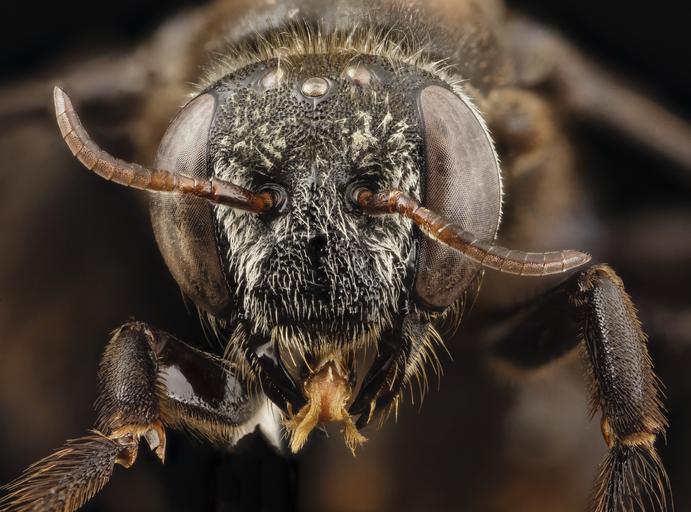MAKE A MEME
View Large Image

| View Original: | bee_09856e08,m,_thailand,_face_2014-08-09-11.29.35_ZS_PMax.jpg (4546x3366) | |||
| Download: | Original | Medium | Small | Thumb |
| Courtesy of: | www.flickr.com | More Like This | ||
| Keywords: apidae apoidea ctenoplectra thailand asia bee bees usgs biml blue scimitar knife oil scraper oilscraper scraper droege entomological entomology sheen reflection stackshot zerene stacker zerenestacker oil animal macro outdoor texture Ctenoplectra, Unknown Blue-tailed Oil Mopping Bee, collected in Thailand by the Thailand Inventory Group for Entomological Research Another Oil Mopping Bee, this an Asian one from Thailand rather than from Africa . Here is a good shot of the large scraper or comb this female has on her hind tibia. This comb is used after visiting flowers to remove floral oils that collect in specialized hairs located on the underside of the bee’s abdomen. In addition to the unusual oil-collecting modifications, this genus has been difficult to classify because of its tongue . As we have seen, bees can be broadly classified into Long- and Short-Tongued families based upon details of the structure of the mouthparts (not simply how long they are). Ctenoplectra has the short-tongued morphology, but has other characteristics that seem to suggest that it is actually more closely related to Long-tongued bees. So different is this genus from all other bees in the world that at one point it was placed in its own family. However, detailed study of morphology and molecules revealed its true affinities and the genus was moved into the family Apidae which contains many other genera of bees. ~~~~~~~~~~{{{{{{0}}}}}}~~~~~~~~~~ All photographs are public domain, feel free to download and use as you wish. Photography Information: Canon Mark II 5D, Zerene Stacker, Stackshot Sled, 65mm Canon MP-E 1-5X macro lens, Twin Macro Flash in Styrofoam Cooler, F5.0, ISO 100, Shutter Speed 200 Further in Summer than the Birds Pathetic from the Grass A minor Nation celebrates Its unobtrusive Mass. No Ordinance be seen So gradual the Grace A pensive Custom it becomes Enlarging Loneliness. Antiquest felt at Noon When August burning low Arise this spectral Canticle Repose to typify Remit as yet no Grace No Furrow on the Glow Yet a Druidic Difference Enhances Nature now -- Emily Dickinson Want some Useful Links to the Techniques We Use? Well now here you go Citizen: Basic USGSBIML set up: www.youtube.com/watch?v=S-_yvIsucOY USGSBIML Photoshopping Technique: Note that we now have added using the burn tool at 50% opacity set to shadows to clean up the halos that bleed into the black background from "hot" color sections of the picture. www.youtube.com/watch?v=Bdmx_8zqvN4 PDF of Basic USGSBIML Photography Set Up: ftp://ftpext.usgs.gov/pub/er/md/laurel/Droege/How%20to%20Take%20MacroPhotographs%20of%20Insects%20BIML%20Lab2.pdf Google Hangout Demonstration of Techniques: plus.google.com/events/c5569losvskrv2nu606ltof8odo or www.youtube.com/watch?v=4c15neFttoU Excellent Technical Form on Stacking: www.photomacrography.net/ Contact information: Sam Droege [email protected] 301 497 5840 Ctenoplectra, Unknown Blue-tailed Oil Mopping Bee, collected in Thailand by the Thailand Inventory Group for Entomological Research Another Oil Mopping Bee, this an Asian one from Thailand rather than from Africa . Here is a good shot of the large scraper or comb this female has on her hind tibia. This comb is used after visiting flowers to remove floral oils that collect in specialized hairs located on the underside of the bee’s abdomen. In addition to the unusual oil-collecting modifications, this genus has been difficult to classify because of its tongue . As we have seen, bees can be broadly classified into Long- and Short-Tongued families based upon details of the structure of the mouthparts (not simply how long they are). Ctenoplectra has the short-tongued morphology, but has other characteristics that seem to suggest that it is actually more closely related to Long-tongued bees. So different is this genus from all other bees in the world that at one point it was placed in its own family. However, detailed study of morphology and molecules revealed its true affinities and the genus was moved into the family Apidae which contains many other genera of bees. ~~~~~~~~~~{{{{{{0}}}}}}~~~~~~~~~~ All photographs are public domain, feel free to download and use as you wish. Photography Information: Canon Mark II 5D, Zerene Stacker, Stackshot Sled, 65mm Canon MP-E 1-5X macro lens, Twin Macro Flash in Styrofoam Cooler, F5.0, ISO 100, Shutter Speed 200 Further in Summer than the Birds Pathetic from the Grass A minor Nation celebrates Its unobtrusive Mass. No Ordinance be seen So gradual the Grace A pensive Custom it becomes Enlarging Loneliness. Antiquest felt at Noon When August burning low Arise this spectral Canticle Repose to typify Remit as yet no Grace No Furrow on the Glow Yet a Druidic Difference Enhances Nature now -- Emily Dickinson Want some Useful Links to the Techniques We Use? Well now here you go Citizen: Basic USGSBIML set up: www.youtube.com/watch?v=S-_yvIsucOY USGSBIML Photoshopping Technique: Note that we now have added using the burn tool at 50% opacity set to shadows to clean up the halos that bleed into the black background from "hot" color sections of the picture. www.youtube.com/watch?v=Bdmx_8zqvN4 PDF of Basic USGSBIML Photography Set Up: ftp://ftpext.usgs.gov/pub/er/md/laurel/Droege/How%20to%20Take%20MacroPhotographs%20of%20Insects%20BIML%20Lab2.pdf Google Hangout Demonstration of Techniques: plus.google.com/events/c5569losvskrv2nu606ltof8odo or www.youtube.com/watch?v=4c15neFttoU Excellent Technical Form on Stacking: www.photomacrography.net/ Contact information: Sam Droege [email protected] 301 497 5840 | ||||